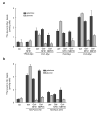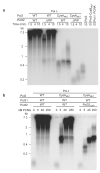Eukaryotic DNA polymerases require an iron-sulfur cluster for the formation of active complexes
- PMID: 22119860
- PMCID: PMC3241888
- DOI: 10.1038/nchembio.721
Eukaryotic DNA polymerases require an iron-sulfur cluster for the formation of active complexes
Abstract
The eukaryotic replicative DNA polymerases (Pol α, δ and ɛ) and the major DNA mutagenesis enzyme Pol ζ contain two conserved cysteine-rich metal-binding motifs (CysA and CysB) in the C-terminal domain (CTD) of their catalytic subunits. Here we demonstrate by in vivo and in vitro approaches the presence of an essential [4Fe-4S] cluster in the CysB motif of all four yeast B-family DNA polymerases. Loss of the [4Fe-4S] cofactor by cysteine ligand mutagenesis in Pol3 destabilized the CTD and abrogated interaction with the Pol31 and Pol32 subunits. Reciprocally, overexpression of accessory subunits increased the amount of the CTD-bound Fe-S cluster. This implies an important physiological role of the Fe-S cluster in polymerase complex stabilization. Further, we demonstrate that the Zn-binding CysA motif is required for PCNA-mediated Pol δ processivity. Together, our findings show that the function of eukaryotic replicative DNA polymerases crucially depends on different metallocenters for accessory subunit recruitment and replisome stability.
Figures









Comment in
-
Nuclear replication: Hidden iron-sulfur clusters.Nat Chem Biol. 2011 Dec 15;8(1):24-5. doi: 10.1038/nchembio.737. Nat Chem Biol. 2011. PMID: 22173356 No abstract available.
References
-
- Johansson E, Macneill SA. The eukaryotic replicative DNA polymerases take shape. Trends Biochem. Sci. 2010;35:339–347. - PubMed
-
- Burgers PM, et al. Eukaryotic DNA polymerases: proposal for a revised nomenclature. J. Biol. Chem. 2001;276:43487–43490. - PubMed
-
- Mäkiniemi M, et al. A novel family of DNA-polymerase-associated B subunits. Trends Biochem Sci. 1999;24:14–16. - PubMed
Publication types
MeSH terms
Substances
Grants and funding
LinkOut - more resources
Full Text Sources
Molecular Biology Databases
Miscellaneous

